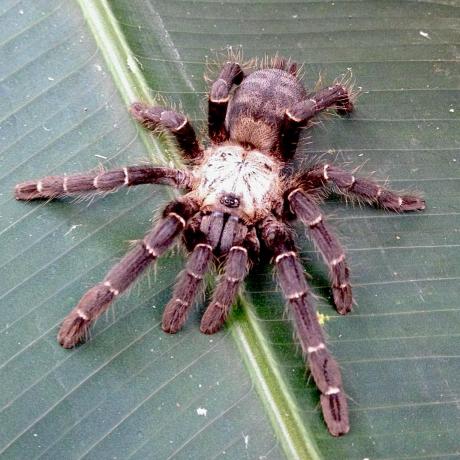

A very rare arboreal tarantula from Thailand which is only found living in the culm of bamboo. This spider was previously known as Ornithoctoninae sp. Mae Hong Son before being formally described and placed into a new genus on its own.
| Origin | Thailand |
|---|---|
| Enclosure Style | Arboreal |
| Temperature | 22-26°C |
| Humidity | 70-80% |
| Legspan | 20cm |
| Temperament | Defensive - Advanced Keepers |
This arboreal tarantula has a fawn to tan carapace that is longer than it is wide. It has distinct dark femurs, with the lower legs having a greyish appearance and light banding between the joints. The abdomen colouration is often referred to as tiger striping. This spider has long and light setae hairs across its abdomen and legs which gives a beautiful contrast to its leg colour. This species can reach sizes of up to 8 inches in leg span.
This newly recorded arboreal species can be found in Tak province Thailand, specifically and unusually they have been located living in the culm of bamboo of the genus Gigantochloa. Studies have also noted them found living between bamboo internodes, typically with nest entrances 2-3cm in diameter in silk lined tubular burrows, some specimens were also found to have secondary entrances without silk at the hole. It is hypothesized that this spider in the wild likely occupies the empty nest of insects, such as the bamboo-nesting carpenter bee Xylocopa and other animals which might attack the bamboo.
The genus is named after the Thai king Taksin the Great and the species name bambus after its discovery within bamboo plantations. It is currently the only described species within its genus.
Keep larger or adult spiders in arboreal glass or suitably sized plastic terrariums. It is important to have enclosures that are ventilated to allow the exchange of air.
Use a suitable soil-based spider substrate and add pieces of decoration such as cork bark or even a hollowed-out piece of bamboo. Add artificial or live plants if you wish and leaf litter for further natural aesthetics.
Keep at temperatures between 22-26°C (72-79°F) and at moderate humidity levels of 70-80% by lightly misting the webbing with a hand sprayer. A small water bowl should also be provided to assist humidity levels and allow easy access to a drink source. Care should be taken to not allow the enclosure humidity to drop too much, or it will quickly dry out the substrate and risk spider dehydration. However, it is also important not to saturate your substrate as this will go stagnant and inevitably risk mould growth.
Feed larger or adult spiders every 7-14 days on suitably sized live food such as crickets, and roaches. All uneaten food must be removed by the next day.
For housing its best to keep young tarantulas in small plastic containers or vials that are ventilated and escape proof. If absent, holes must be formed or drilled into small plastic containers or meshing added to allow the exchange of air.
Use a soil-based spider substrate and add decoration if room allows such as broken and offcut pieces of cork bark into the enclosure.
Spiderlings should be fed every 5-7 days on suitably sized food such as crickets. Do not be scared to give them insects even of a similar size to themselves, they will often take prey of this size down comfortably. All uneaten food must be removed by the next day.